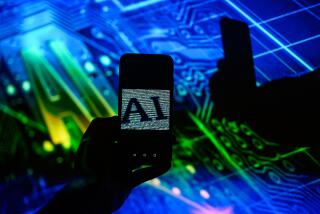With Tech’s Speedy Advances Comes Risk of Disconnect
I recently watched the sci-fi classic “Blade Runner” with my 12-year-old son. In that film’s creepy, not-too-distant future, genetic engineers have created “replicants”--androids so human-like that they have feelings, desires and even memories of childhood never experienced. Created as slaves, some replicants turn against their makers.
Afterward he asked me how realistic this might ultimately prove. He found my answer more disturbing than the movie’s heavy-handed vision: New technologies will change the world in vast, unpredictable and probably uncontrollable ways before my son reaches middle age. Change may be good, but too much change causes a kind of “future sickness” that my son may already be feeling the early effects of.
Until the last 30 years or so, key modern technologies that profoundly altered everyday life also stabilized quickly. Mass-production assembly lines, the telephone, television, the automobile and the airplane became better, more widely used or faster. But their basic functions remained unchanged for decades.
The microprocessor replaced that model of technological development with one of continual renewal. Because processors double in power while dropping by half in size and cost every 18 to 24 months, they reach no natural plateau--so devices based on microprocessors constantly morph and evolve. Not just a faster mainframe computer, but the power of a mainframe on every desktop. Not just a better PC but a hand-held PC . . .
Computers, cell phones, voicemail, video games, the Internet, the Web, e-mail and telecommuting have transformed the economy, business, leisure, education and culture. In a single generation, they have remade everyday life.
And just as audiotapes were doomed by CDs, now being eclipsed by digital audio downloaded from the Web in a relative eye blink, most of today’s technologies will be gone or radically different within a few years.
In such a world, the cliche about being unable to program one’s VCR gives way to a daily struggle with “essential” gadgets introduced with mind-numbing rapidity. This is a cause for “hurry sickness”--deftly chronicled in James Gleick’s book, “Faster: The Acceleration of Just About Everything.”
The churn of machine-mediated lives creates a constant need to rethink our situation, reconfigure our activities in a multitude of small ways, remake our companies in a few months and transform our economy in a few years. For all its material benefits, such rapid change has proved painfully difficult for many to adjust to.
“We live in a manic culture. The underside of a manic culture is a depressed culture,” said historian David Noble. Noble, a professor at York University in Toronto and a leading scholar on the history of technology, was reflecting on the rise of the antidepressant Prozac and other chemical coping tools. “Both the manic and depressive are fatal to individuals, to society and culture, and fatal to the future.”
Noble calls this a period of “calamitous destabilization.”
That may be an exaggeration, but give it time.
Robotics, miniaturization and genetic engineering are now well enough understood to reasonably predict the advent of self-replicating “thinking machines.” Such devices will approach or improve upon behaviors now viewed as uniquely human, as Bill Joy, chief scientist of Sun Microsystems, recently pointed out in a lonely call to rethink how we are developing those technologies to avoid possible disasters.
Joy’s fears, like “Blade Runner,” may prove overdrawn. But when such machines arrive they will change the world unpredictably.
It wasn’t the likelihood of powerful and possibly uncontrollable technologies that scared my son. It was the idea that such technologies might reduce today’s world to irrelevance--challenging a sense of long-term connection that seems essential to human identity.
Don’t mistake this for typical growing pains on his part or nostalgia on my own. Aside from war, famine, mass migration or natural disaster, until little more than 150 years ago the differences in the lives of one generation to the next were imperceptibly slight, except in the hindsight of history.
In contrast, the “Leave It To Beaver” period of my childhood already seems increasingly anachronistic, like the concept of lifetime employment at the same company. My Internet-savvy son felt an uneasy premonition that this time in his life will soon seem even more remote--lost in the online ether.
He and I share a great deal, but little that I identified as central elements of my life at his age. One exception: playing and watching sports, which offer reassuring continuity across the generations.
Digital technologies, by nature, promote discontinuity. They are about parsing information into fragments--0s and 1s--and rearranging the bits. Our interactions with technology often promise connection yet atomize relationships. We’ve become 24-7, call-waiting, cell-phone nomads. We fire off e-mails across the globe while next-door neighbors remain strangers.
Digital technology separates us as it channels our experience, offering seductive efficiency as it raises walls of complexity between people.
In this fiber-optical modern world, my son may want to believe that his life will resemble my own enough so that my advice and experience will enlighten his future.
Noble believes that I may be unqualified for such a role because the rate of change is ending “intergenerational continuity” with the current generation.
Call it the vanity of fatherhood, but I believe that he overstates the case.
Even so, the imperatives of capitalism and the technology industry define relentless and urgent change as a core creative virtue. Commercial success has steamrollered the skeptics, though the general public remains conflicted.
In recent polls, Americans tended to describe specific technologies, such as the PC or the Internet, as benign or beneficial. But many blamed technology more generally for accelerating already-frantic lifestyles or creating more problems than they solve.
Such ambivalence suggests battle fatigue. When things change so fast, reflection becomes the first casualty, and at great cost: the loss of genuine consent.
*
Times staff writer Charles Piller can be reached at [email protected]. Recent Innovation columns are available at http://vinapk.com/innovation.






